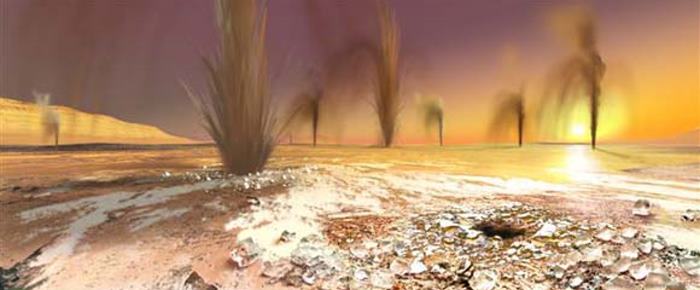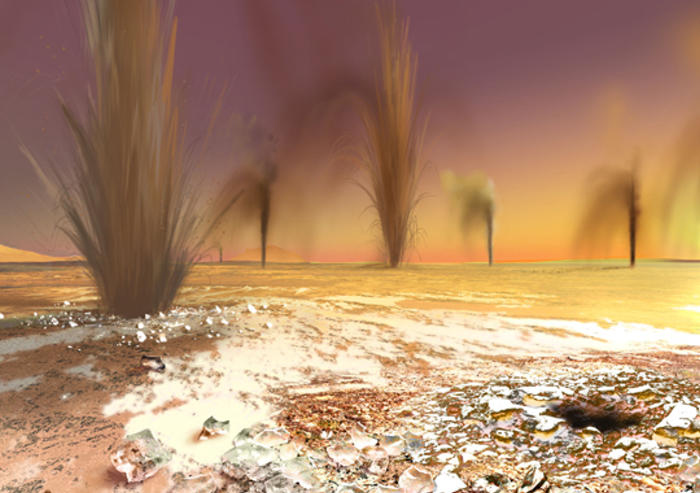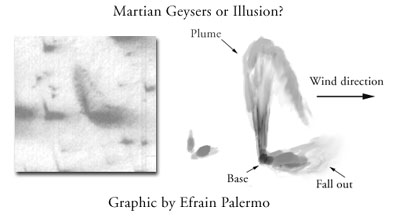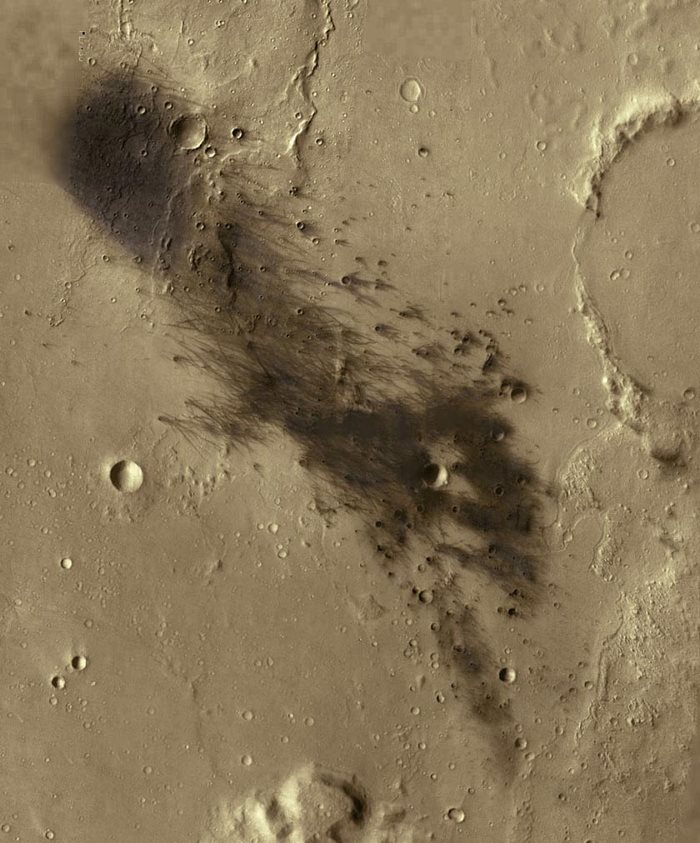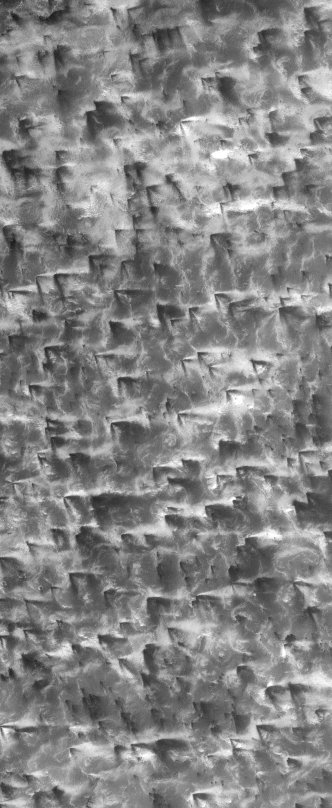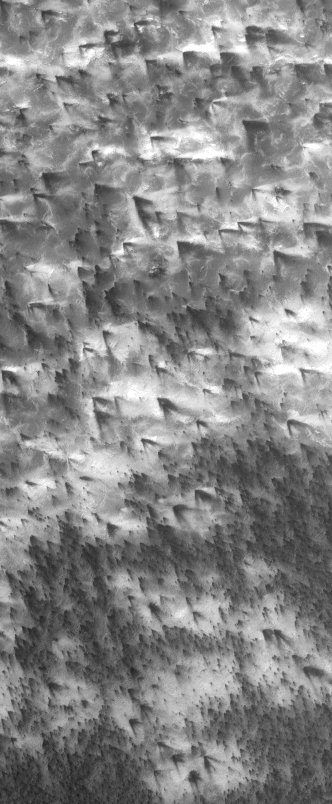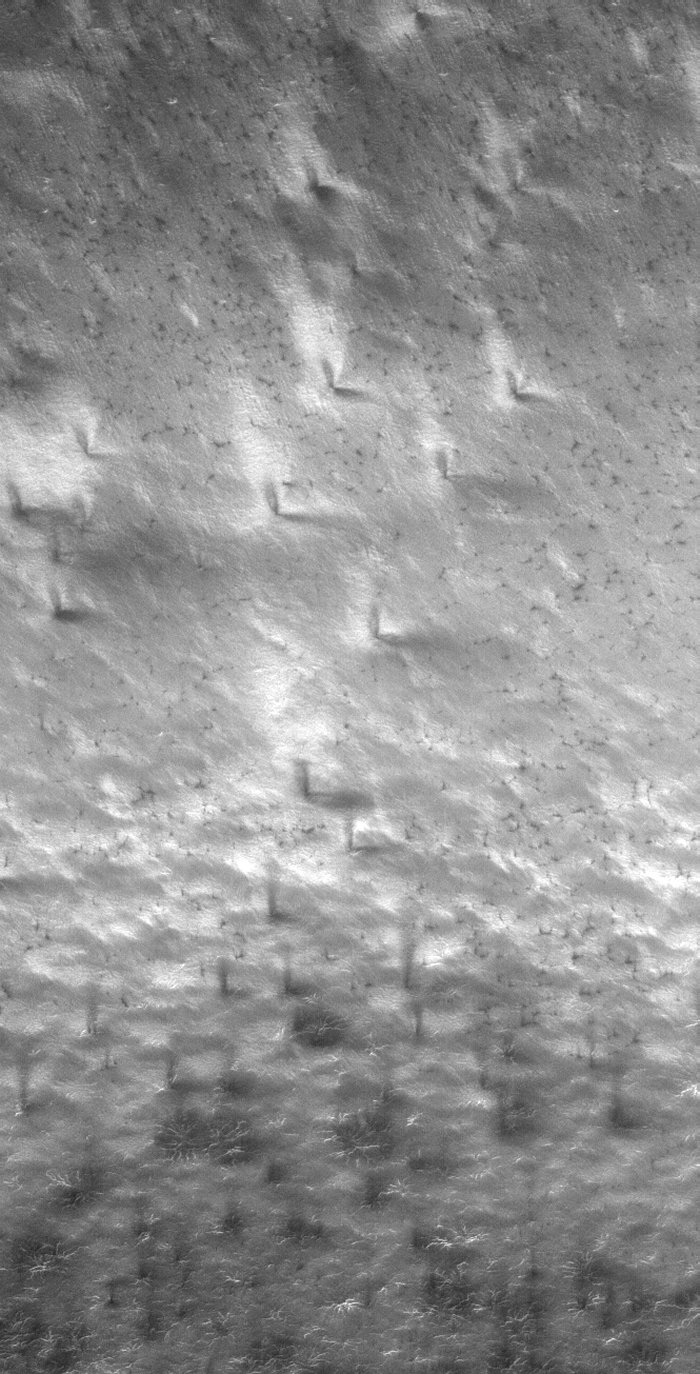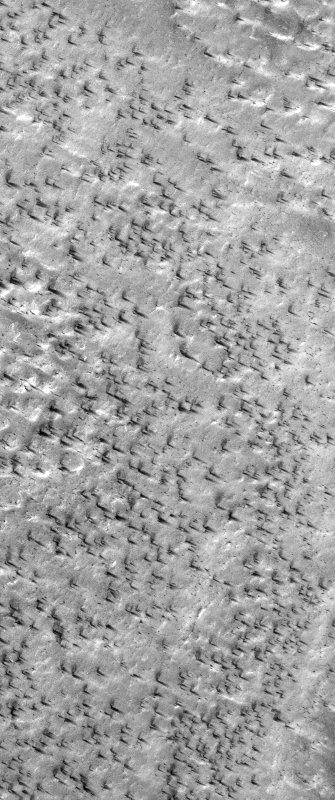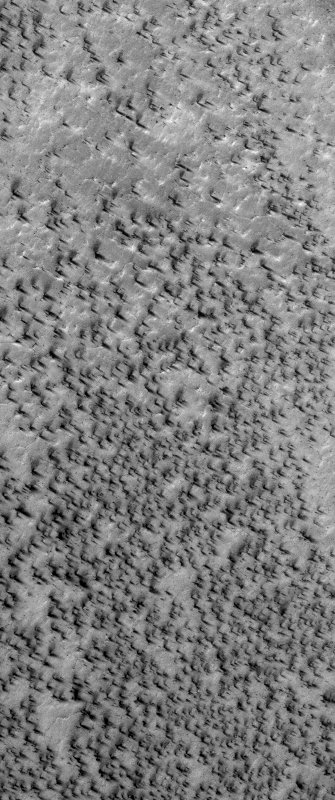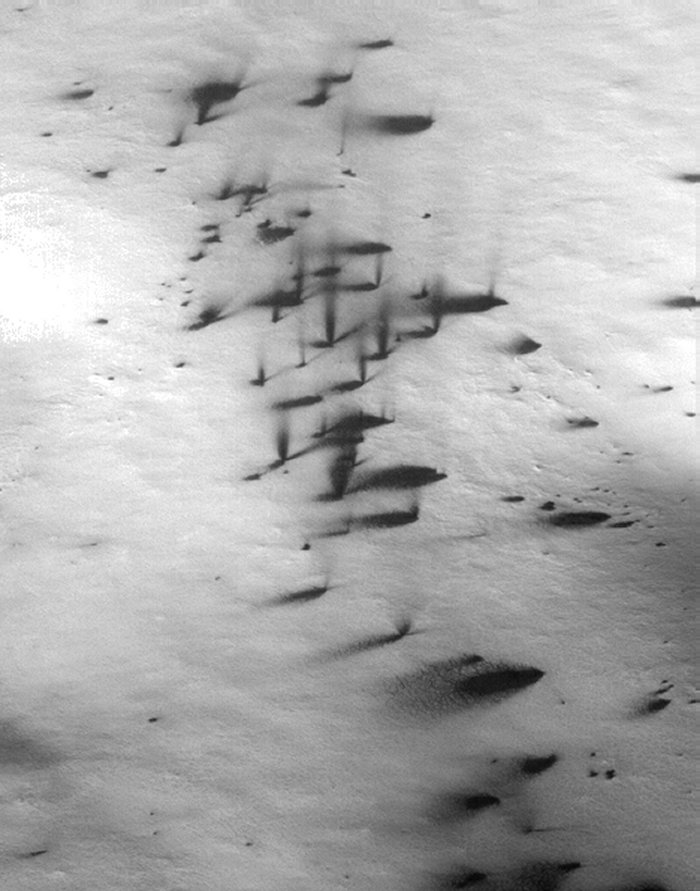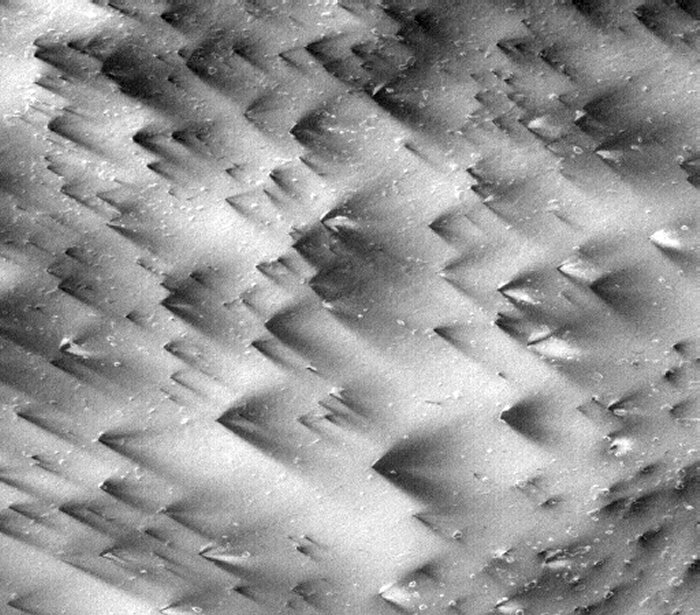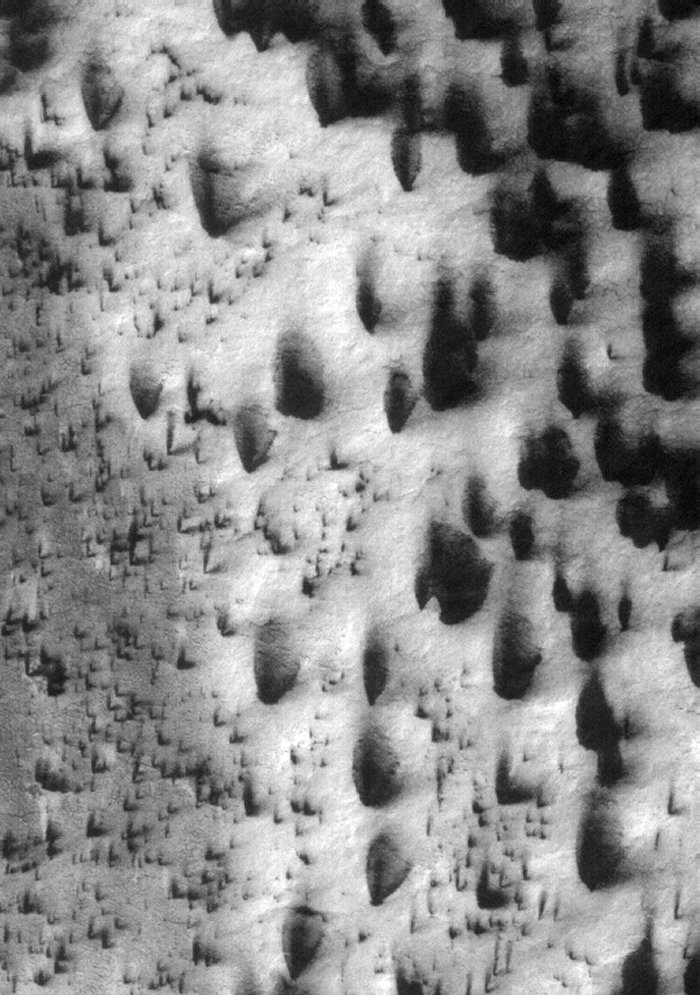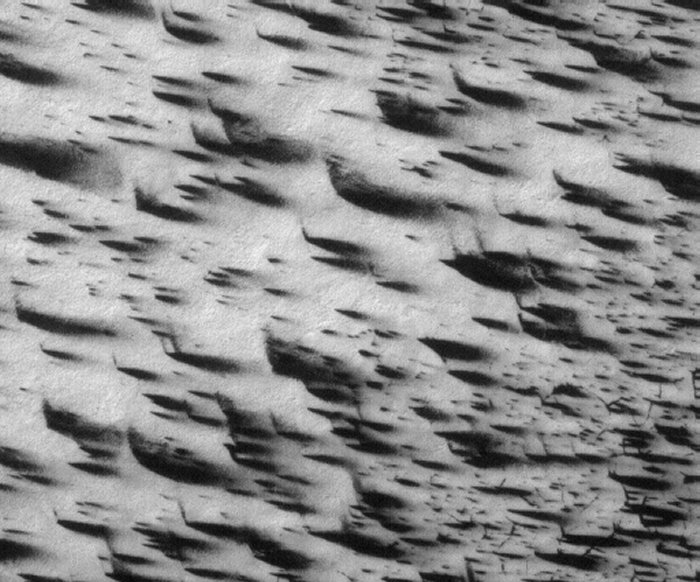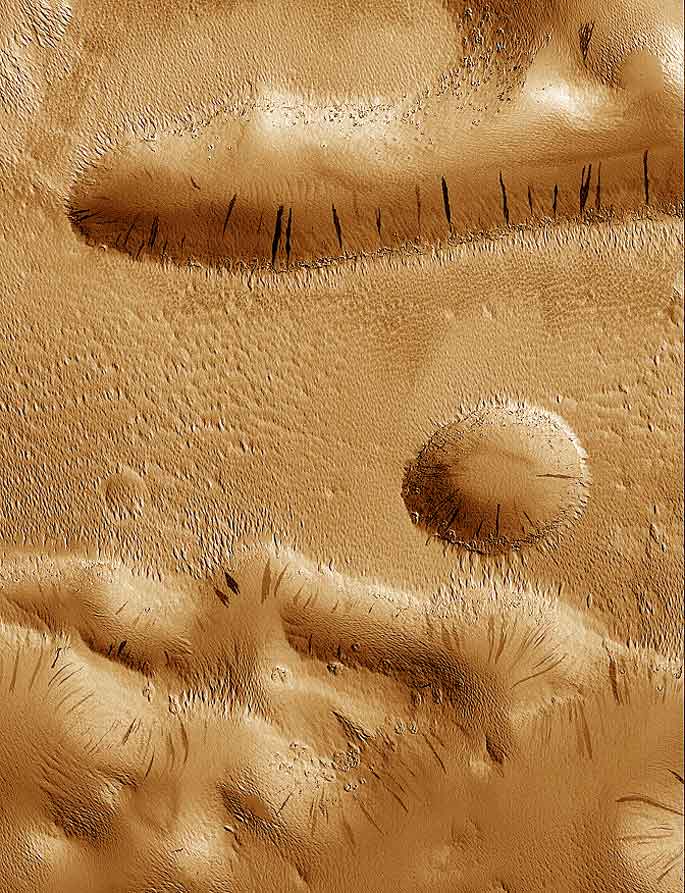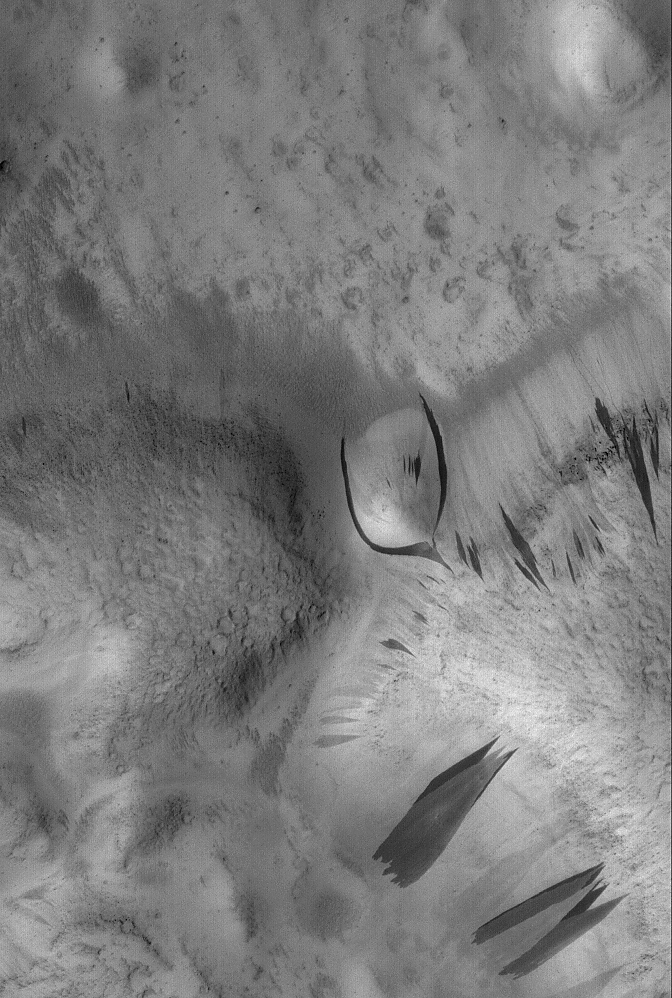|
The Enigmas on Mars 10a |
||
|
. Spring Arrives With a Bang Sand-laden jets shoot into the polar sky in this view by noted space artist Ron Miller. It shows the Martian south polar icecap as southern spring begins. Sunday, 20 August 2006
Excerpt: Geysers spewing sand and dust hundreds of feet into the "air" have been discovered on Mars, scientists say. Images from a camera orbiting Mars have shown the 100 mph jets of carbon dioxide erupt through ice at the planet's south pole, Arizona State University says. The orbiting camera, called the Thermal Emission Imaging System (Themis), is on the Mars Odyssey probe.The geyser debris leaves dark spots, fan-like markings and spider-shaped features on the ice cap. The scientists said geysers erupted when sunlight warming the ice turned frozen carbon dioxide underground into high-pressure gas. "If you were there, you'd be standing on a slab of carbon dioxide ice," said the university's Dr Phil Christensen."All around you, roaring jets of CO2 gas are throwing sand and dust a couple of hundred feet into the air." Dr Christensen said the process was "unlike anything that occurs on Earth". His team discovered the jets through examining more than 200 Themis visible and infrared images. The findings were published in the latest edition of the journal Nature. |
||
|
||
|
Monday 21st August 2006
Excerpt: Every spring, the southern polar cap on Mars almost fizzes with carbon dioxide, as the surface is broken by hundreds of geysers throwing sand and dust hundreds of feet into the Martian "air". The discovery was announced in the journal Nature by researchers at the Arizona State University, based on data from the Thermal Emission Imaging System on the Mars Odyssey orbiter. Images sent back by the probe showed that as the sun began to warm the pole, the polar cap began to break out in dark spots. Over the days and weeks that followed, these spots formed fan-like markings, and spidery patterns. As the sun rose higher in the Martian sky, the spots and fans became more numerous. "Originally, scientists thought the spots were
patches of warm, bare
ground exposed as the ice disappeared," said lead
scientist Phil Christensen.
"But observations made with THEMIS on NASA's Mars
Odyssey orbiter told
us the spots were nearly as cold as the carbon dioxide
ice, which is at
minus 198 degrees Fahrenheit."
The team concluded that the dark spots were in fact geysers, and the fans that appeared were caused by the debris from the eruptions. Artist's impression of how the Martian geysers may look. Pic: Arizona State University/Ron Miller Christensen said: "If you were there, you'd be standing on a slab of carbon-dioxide ice. Looking down, you would see dark ground below the three foot thick ice layer. "The ice slab you're standing on is levitated above the ground by the pressure of gas at the base of the ice." He explains that as the sunlight hits the region in the spring, it warms the dark ground enough that the ice touching the ground is vaporised. The gas builds up under the ice until it is highly pressurised and finally breaks through the surface layer. As the gas escapes, it carries the smaller, finer particles of the soil along with it, forming grooves under the ice. This "spider" effect indicates a spot where a geyser is established, and will form again the following year. ® |
||
|
ESA Mars Express .
This colour picture was taken by the HRSC camera on board ESA's Mars Express, from an altitude of 320 kilometres. It shows the centre of crater Gusev with the landing site of the NASA Spirit rover (marked). Gusev is a crater of 160 kilometres diameter. Earlier in the history of Mars, it appears that this area was covered by water. Because of the probable existence of sediments from this ‘lake’, Gusev is a highly interesting target in the search for traces of water and life on Mars. The area shown measures about 60 kilometres across at the bottom; North is at the top. SOURCE: ESA Mars Express |
||
|
.
Image Source Malin E07-01445 |
||
|
.
This is from the center of the entire image and shows many perfectly defined geysers. They are sparce at the top of the inage, and increase to the bottom, then the image displays the "spider" effect commonly seen in this area. Further down the image the spiders increase and the geysers decrease, indicating that the spiders may be a second stage event after the geysers. Image Source Malin E08-00337 |
||
|
.
Again the geysers increase in numbers to the bottom perhaps indicating a progression Image Source Malin E08-01604 |
||
|
.
These are some very clear tall ones....These are the only ones in the big image of note and are located in the bottom corner. The above image has been inverted to better view them. Image Source Malin M07-01830 |
||
|
.
Interesting spray pattern in this group, The bottom of the full image is covered in strange looking rows of spheres.. Image Source Malin M07-01940 |
||
|
.
Very large and wide ones in this photo on the right side...clearly visible "rays" in the fans Image Source Malin M08-02966 |
||
|
.
In this image you see the smaller jets and clearly see the larger ejecta deposit areas... Image Source Malin M08-03500 |
||
|
.
Color image showing large jets along the edge of the depressions... Image Source Malin M11_01809 |
||
|
MGS MOC Release No. MOC2-1556, 16 August 2006 S18 02576 .
"This Mars Global Surveyor (MGS) Mars Orbiter Camera (MOC) image shows some dark slope streaks in the Phlegra Dorsa region of Mars. Of particular interest is the split streak near the center of the image, which diverted around a rounded hill as the material was sliding down the slope. Slope streaks occur in regions of Mars that are mantled by fine, bright dust. They do not occur on slopes that have no dust coating. They are therefore suspected to form by dry avalanching of the dust, despite their somewhat fluid appearance." - Malin Space Very Alien looking scenery...
|
||
| FAIR USE NOTICE: This page contains copyrighted material the use of which has not been specifically authorized by the copyright owner. Pegasus Research Consortium distributes this material without profit to those who have expressed a prior interest in receiving the included information for research and educational purposes. We believe this constitutes a fair use of any such copyrighted material as provided for in 17 U.S.C § 107. If you wish to use copyrighted material from this site for purposes of your own that go beyond fair use, you must obtain permission from the copyright owner. | ||
|
|
